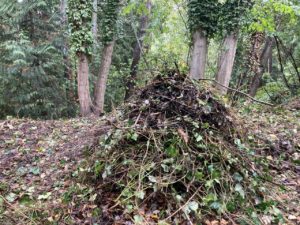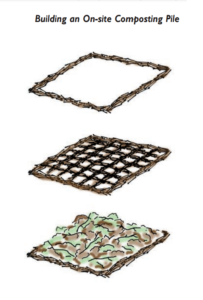Onsite Composting: Explaining Our Mess

During spring and summer, DNDA volunteer events focus on removing highly prolific, fast growing plants such as Himalayan blackberry and English ivy. These plants can readily overtake forested areas and outcompete native plants for nutrients and resources, lowering the biodiversity in the area. Pacific Northwest native plants have adapted to local climate conditions and do an excellent job of filtering air and water and supporting wildlife. By removing highly prolific plants, DNDA hopes to assist in restoring our urban forests by supporting a variety of native plant growth and creating space for more once planting season begins in the fall. One of the questions that arises, however, is what to do with the plant material that is removed from the ground.

We construct our compost piles by building platforms out of fallen tree limbs and branches that do not pose a risk to re-rooting into the forest floor. These platforms enhance airflow under and through the pile to speed the drying process. Once the plant material is completely dry and cannot re-root, the “mulch” is spread, helping the soil retain moisture. The long-term breakdown of plant material returns nutrients to the system.
While onsite composting helps to reduce waste and prevent the spread of highly prolific plants, there are some key details to keep in mind when maintaining our piles and sites.
- The size of the piles can impact the time of drying: smaller piles dry out faster, though creating too many can impact the space left for new plants, especially around planting season, and requires a lot of downed wood which may not be present in sites lacking an extensive canopy.
- Adding fresh plant material to existing piles can slow the drying process. We try to create and add to new piles at successive volunteer events.
- Leaving a pile dormant for too long can increase the risk of it being overgrown by blackberry or other plants still present in the ground.
- Spreading the completely dried plant material helps to prevent piles from overtaking a space, frees up tree limbs to create new platforms for fresh plant material, and creates room for new native plants.
- Completely clearing an area before creating new platforms helps to prevent these highly prolific plants from growing through or over existing piles.
Onsite composting is a great tool in aiding the restoration efforts of our greenspaces and preventing the spread of invasive plants to other parts of the city. If you happen to come across one of our piles, please know we are in the process of removing these highly prolific plants and reusing them to nurture our natural environment.
Written by Ella Goodheart, DNDA Urban Forest Restoration Intern

